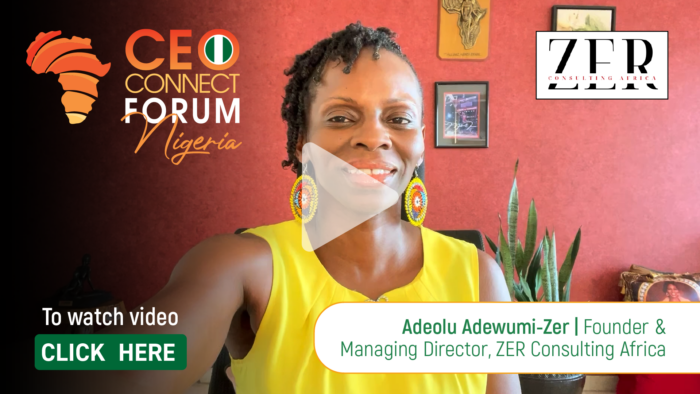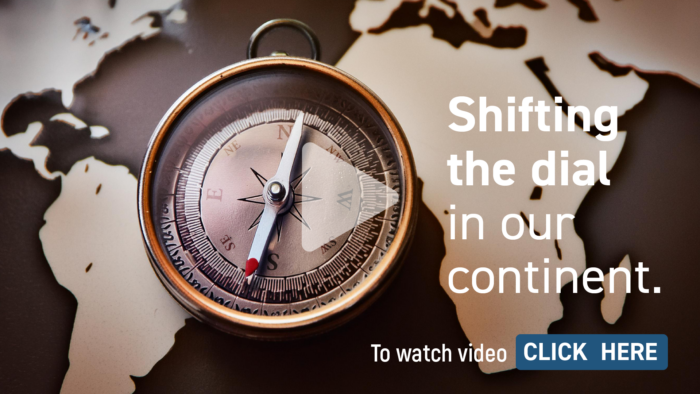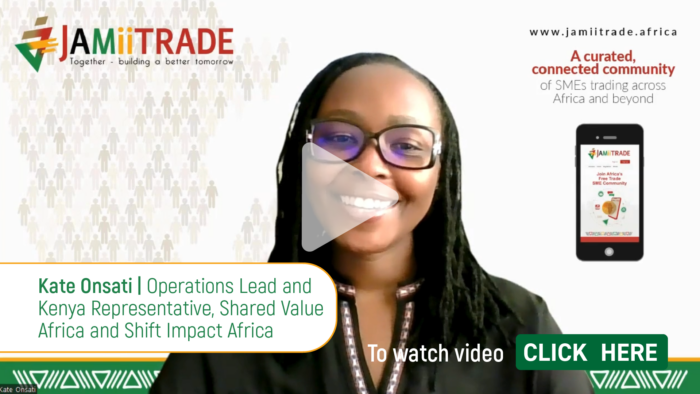In Conversation With Enel Group’s Maria Cristina Papetti
We sit down with Maria Cristina Papetti, Head of Global Sustainability, Infrastructure and Networks at the Enel Group, to talk about her Shared Value Journey at an organisation that offers everyone, everywhere the opportunity to create new value through the innovative use of energy. We learn about important milestones along the way and discover the key to the success of this renewable energy leader.
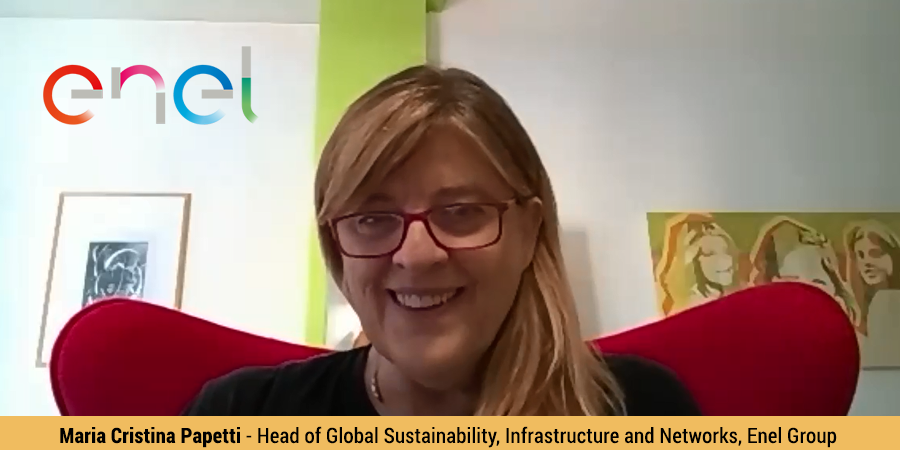
Q: How did your Shared Value Journey at Enel start?
We started towards the end of 2011 with Shared Value at Enel Green Power, a relatively new renewable energy company within the Enel Group. Ten years ago, the concept of renewable energy was very new and we had to educate and get people to understand the potential of lowering emissions, improving our impact on the environment and climate change, in general.
Back then, when we started exploring green energies, we were fortunate to have both a visionary CEO and CFO at Enel Green Power (EGP) – Francesco Starace and Alberto De Paoli, respectively. They realised early on that sustainability was a key lever for growing renewable power generation. We also recognised that, even with green energies, one need to consider the environmental and social impacts of the business.
However, conventional corporate social responsibility approaches offered little insights into how sustainability could be systematically integrated into our value chains. More importantly, the traditional CSR approach was unfit for the growth path we had in mind, in particular growth in the so-called emerging markets.
In doing research on this subject, I came across the various articles written by Michael Porter and Mark Kramer in the Harvard Business Review, which talked about a new form of capitalism – the concept of creating shared value (CSV).
At the time, it was just an academic idea, but it offered a useful conceptual framework for us to enhance our business model, which comprised the construction, operation, and maintenance of renewable energy generation assets in local communities.
During those early years, as we started out on this incredible and never-ending journey, we were actually translating CSV from an academic concept into a practical model for understanding societal needs in specific local contexts – based on unique requirements of both our industry and or our company.
What did this mean? In practice, we tried to understand how to integrate the shared value approach idea into the value chain of our business model. This was relatively easy in the beginning, as we were focusing on business development, engineering and construction, and operations. In order to engage people from the lines of business, we had to first integrate the shared value model into the business processes and into the organisation. We also had to adopt a very strict methodology and developed [what we called] CSV tools such as country analyses, stakeholder engagement models, materiality metrics, risk controllers and the CSV plan.
For us this was truly a journey and one that involved thousands of people inside Enel Green Power and working in the value chain to develop and apply the CSV model throughout the business.
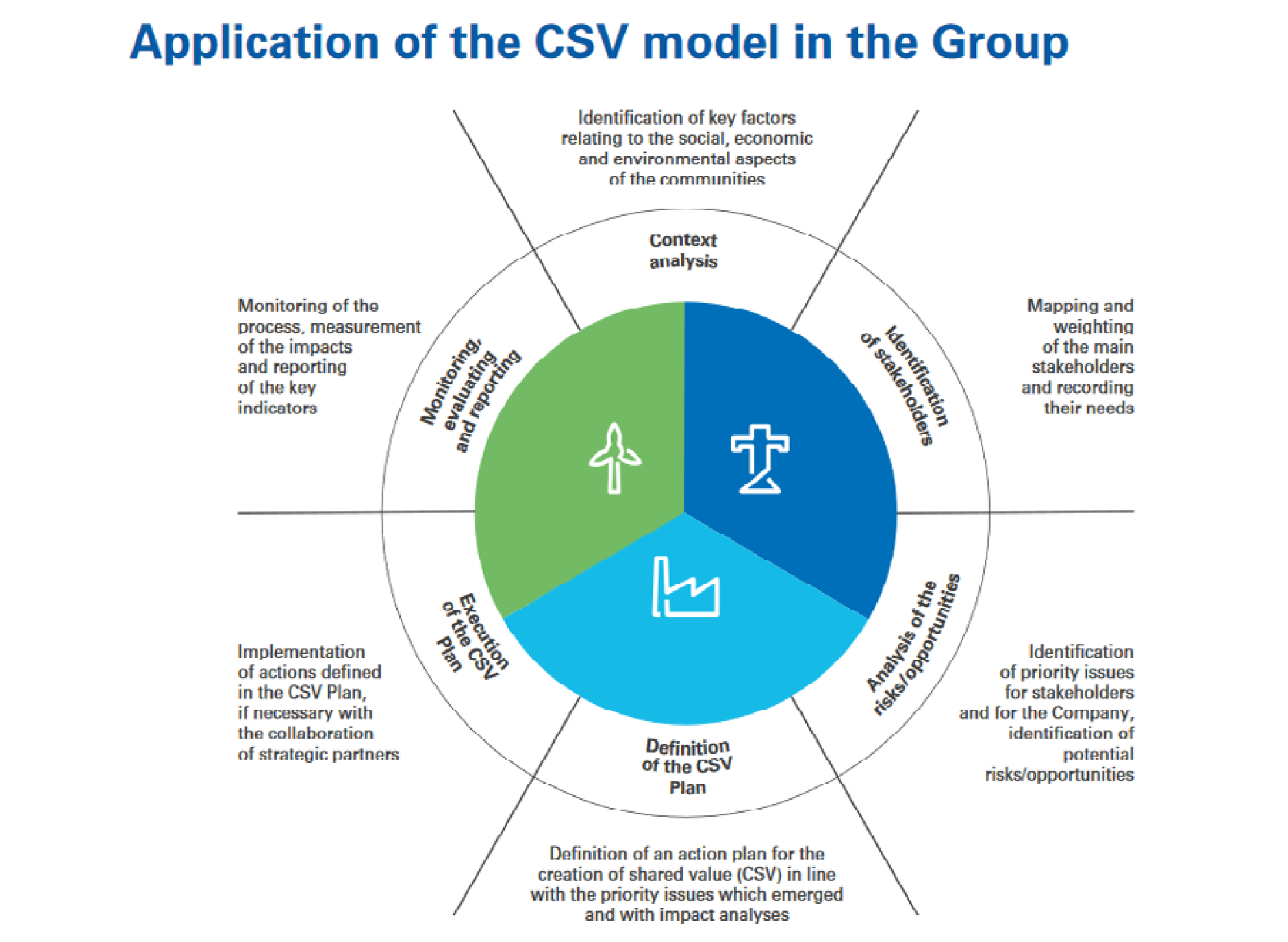
Q: What were some of the key milestones along the way?
A key achievement and great victory was when we introduced the CSV concept to the investment committee of the Enel Group. For us this meant that people from the lines of business were now also starting to take into account the social and environmental aspects of every new business opportunity.
It also meant that we started using shared value in our business model. For example, we included in the planning of each new renewable plant, important input from relationships with those in the territories in question and listening to and understanding their needs, training members of the community with new skills and promoting development.
This also resonated with Mark Kramer’s belief that shared value is ultimately about creating business opportunities by solving social issues. For us it was very evident that, if we were entering into a business opportunity where the people and communities [our stakeholders, generally speaking] did not understand exactly what we wanted to do, then our stakeholders became a barrier to investment.
For us everything started in this way – finding the business opportunity by solving a societal challenge. That, for us, was the beginning of our shared value journey and our story.
Q: In the early days when you were translating the CSV theory into business reality, what made it all come together?
Our journey would not have been possible without our leadership: a visionary CEO and CFO, both who understood right from the beginning that shared value was key to growing as a company.
For us this became a strategic and competitive advantage, which helped us in the long haul. In fact, some of the big issues that we were tackling back then were translated into the United Nations’ 17 SDGs a few years later. Linking some of those SDGs to our strategy, while challenging, also became an integral part of how we were able to perform and execute our strategy and business model.
I believe that having the commitment, engagement and involvement of our CEO and CFO were crucial to our success. Equally important was speaking the business language, as well as giving and showing evidence that applying the CSV methodology is much more than a philosophy or approach – demonstrating that it is a win-win business process.
I remember that one of the most difficult people to convince were those in engineering and construction, as well as the communities on the ground. For example, in Guatemala when we had the opportunity to start construction of a solar or wind development or even the geothermal developments in Chile, people were not happy. Even though we were talking about renewable energies, people at the local community level did not understand what we were doing. The typical approach was for big corporations to provide some form of monetary compensation. We had to change that cultural mindset from compensation into a co-design perspective, one that will foster social economic development in a win-win way.
In fact, it was a cultural revolution to get communities to understand that we were not going to just give them money to spend, but that we need to consider the possibilities and the opportunities for us to develop together. Specifically in terms of job creation at local level and using innovation to improve the way in which they were dealing with agriculture or fishing or tourism.
This approach is key to our success. In our business, we are not selling products. We are going to stay in a community for 20 to 30 years, which means it is important for everyone to work together in the community and to talk with the people, with the engineers.
If you are opening a construction site and the local communities do not understand the reason why you will be making so much noise or creating a lot of dust, they will riot and stop the work – this will cost the business money.
We had to get our engineers and construction people to understand the importance of getting communities to understand what we are doing and, vice versa, for us to understand what they need.
In most of these communities, for instance, there were people desperately looking for jobs. Another example is the containers, which we used on-site during the construction phase. These units could be given to the community, once construction was completed, to be used as a school or emergency facility or for anything else, which was needed at that time.
This was the type of dialogue we started, building trust and new relationships at the community level. This, for us, was both the starting point and the turning point in transforming the relationship.
During your Shared Value journey, when did you start measuring the impact of your CSV strategy?
At the beginning, there was no official impact model available. Together with the Shared Value Initiative, we tested all the various tentative models at the time but in the end, decided to create our own. We linked it to the business measurement model and added many other KPIs related to social and environmental issues.
Today’s measurement model has matured considerably, yet it continues to evolve. For instance, right now we are thinking of including the circular economy approach, which in my opinion is also another way to create shared value.
As before, there are many different measurement models, like the lifecycle assessment and API, which we have to test and try. For me our Shared Value journey is a never-ending story and just when you think you have reached the end, there will always be another road to follow.
Considering the circular economy, what does the Shared Value future holds for Enel?
We have come a long way on our Shared Value journey over the past ten years. It was crucial for everyone at Enel Green Power to understand exactly the direction of the business and to be coherent with both strategy and direction. This meant we had to adopt a singular purpose – identify the reason why we existed.
Today our purpose is clearly articulated as “open power for a brighter future.” In other words, we open up power by giving more people access to energy; we open up to new technologies as far as electricity and energy generation go; we open up to innovation and new partnerships; and we open up to new ways of using energy. In brief, we want to lead the transformation of the energy sector with an open strategy that focuses on sustainability and innovation.
Having a clearly defined purpose also made it easier to develop the strategy and business model, as well as define the desired results we expected from successful execution of the strategy.
We are linking our strategy to both our purpose and the SDGs, which means that our strategic plan now for the first time extends up to 2030. It a 10-year plan that pursues shared value creation through a focus on electrifying energy consumption (SDG 7), decarbonising energy generation (SDG 13) and platformisation, which implies the circular economy, focuses on the value of the ecosystem and touches on multiple SDGs.
These three drivers – electrification, decarbonisation and platformisation – mapped out a clear path for us to create shared value through mitigating climate change and expanding energy access.
By using a platform-based approach, we are also able to create digital solutions to make complex things simple. Our smart technologies help our customers discover new ways to transform the use of energy in four main areas: cities, homes, businesses, and electric mobility.
The world is going digital and to digitalise you need a lot of energy in a way that is more flexible and more reliable in terms of not only generating energy, but also the distribution of energy. The latter, in fact, is the bridge to connect people and our customers – to give them a reliable, accountable, affordable and green form of energy, offering different products and services.
However, at the same time, we also cannot forget the most isolated parts of the world, the rural parts of the world that also need access to electricity. Here our strategic drivers remain the same – electrification, decarbonisation and platformisation – and we are moving straight in that direction.
Adopting the CSV approach and defining our purpose have led us to the strategy we have today. By creating shared value, we have been able to embed sustainability into our strategy, operations and business model.
Our purpose, our strategy, our investments and our results – everything is coherent, connected and integrated. When we started, this was all a dream and now I have seen that dream come true. On top of it, we have also managed to change our industry for the better, little by little.
In conclusion, is there anything that really stood out for you along your Shared Value journey?
Success on this journey is about listening and understanding, never alone but together from an ecosystem perspective. So, for me there are three very important truths that have to have to co-exist, together – listening, understanding and working together.
This is also an integral part of our shared value business model, namely working in partnership; cooperation with non-governmental organisations, social projects, communities and other to intercept innovative ideas and transform them into reality.
With this approach, we have been able to create many projects in diverse African countries, creating employment opportunities for young people and adults, encouraging the education of the young generations and an overall improvement of the living conditions of the community.
It is this ecosystem perspective, which lies at the core of any CSV journey, for any business.
ABOUT MARIA CRISTINA PAPETTI
Prior to her appointment in last year as Head of Global Sustainability, Infrastructure and Networks at the Enel Group, Maria Cristina Papetti was leading the CSV, Sustainability Projects and Practice Sharing Unit of the Group. She worked in Edison, Ferrovie dello Stato and Trenitalia before joining Enel in September 2007. She has been in charge of Executive Education, Executive Education and Cross Cultural Center, International Internal Communication and in January 2012 she has been appointed Head of External Relation of Enel Green Power, managing at international level both Communication and Sustainability activities, and started to deploy the Creating Shared Value (CSV) approach inside the company. Since October 2014, she has been leading the CSV, Sustainability Projects and Practice Sharing Unit, within the Innovation & Sustainability Function of Enel Holding being in charge, among others, of the CSV deployment throughout the business value chain of the entire Group: a sustainability model embedded into business, which allows to increase competitive advantage and catching new opportunities tackling social needs.


